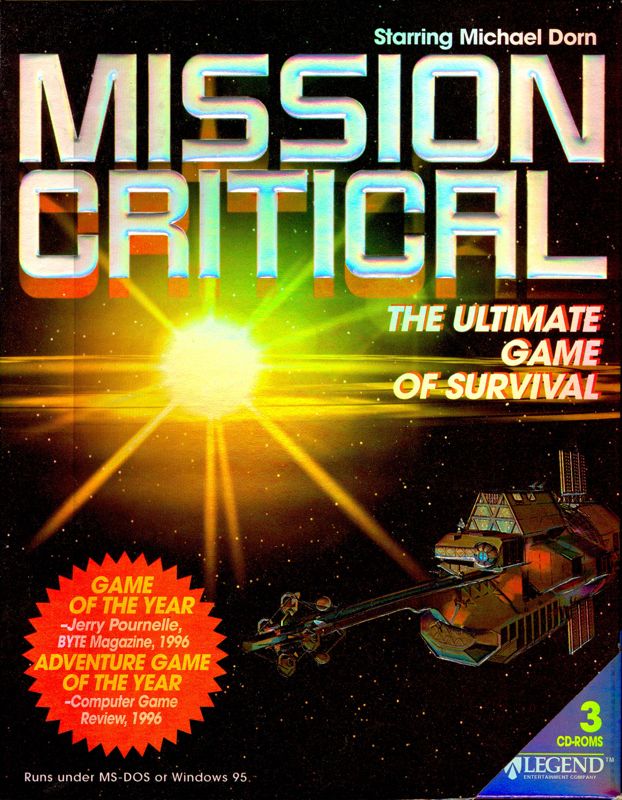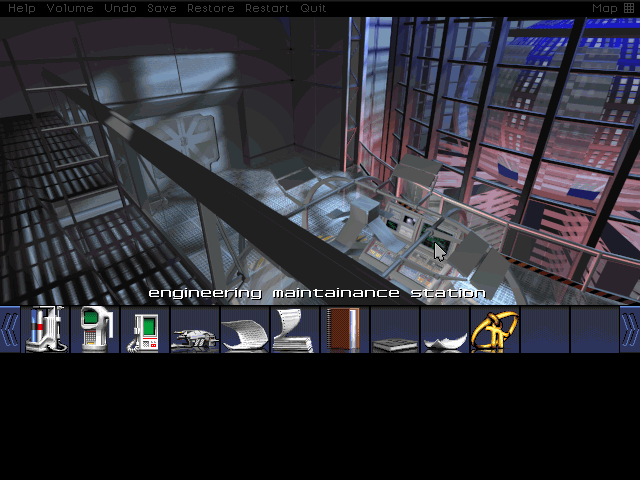Retro Replay Review
Gameplay
Mission Critical delivers a tense and varied gameplay experience that seamlessly blends point-and-click exploration with real-time strategy elements. From the moment you regain consciousness aboard the crippled USS Lexington, you’re immersed in a race against time to repair hull breaches, stabilize reactors, and reboot the ship’s central computer. The real-time clock adds a palpable sense of urgency, forcing you to prioritize tasks and adapt on the fly.
(HEY YOU!! We hope you enjoy! We try not to run ads. So basically, this is a very expensive hobby running this site. Please consider joining us for updates, forums, and more. Network w/ us to make some cash or friends while retro gaming, and you can win some free retro games for posting. Okay, carry on 👍)
Inventory-based puzzles form the core of the adventure, requiring careful observation of your surroundings and creative use of limited resources. You’ll jury-rig power conduits, assemble makeshift tools, and decrypt encrypted data logs to unlock new areas. The challenge curve is well-crafted: early puzzles serve as tutorials, while later sequences demand multi-step solutions and frequent backtracking, rewarding patience and methodical thinking.
Interspersed with the classic adventure mechanics is a lightweight 3D real-time strategy (RTS) segment where you command ship defenses against incoming UN attack drones. This mini-game offers adjustable difficulty settings, catering to both puzzle purists and strategy enthusiasts. Though simplistic compared to standalone RTS titles, it injects bursts of action and tactical decision-making into the narrative flow.
The pacing strikes a fine balance: moments of contemplative exploration are punctuated by sudden crises that test your reflexes and strategic planning. Whether you’re hunting for replacement parts in darkened corridors or intercepting encrypted transmissions, Mission Critical keeps you engaged with a steady rotation of objectives and obstacles.
Graphics
Visually, Mission Critical embraces a richly detailed sci-fi aesthetic characteristic of mid-90s graphic adventures. The interior of the USS Lexington is rendered with meticulous pixel art, showcasing flickering consoles, sparking pipes, and shattered bulkheads that heighten the atmosphere of desperation. Lighting effects, such as emergency red strobes and glowing reactor cores, contribute to a sense of immersion despite the era’s hardware limitations.
The transition to the planetary surface of Persephone introduces more varied environments, from wind-swept deserts to lush alien ruins. Texture work here is more subdued but effective, using earthy tones and organic shapes to contrast with the ship’s industrial corridors. Though the color palette can sometimes feel muted, it reinforces the game’s bleak wartime setting and keeps visual distractions to a minimum during puzzle-solving segments.
The 3D RTS sequences employ simple polygonal models and flat-shaded units, a noticeable departure from the hand-drawn backgrounds. While these segments lack high-end fidelity, their clean presentation ensures clarity during frantic defense missions. On modest hardware, the game maintains a steady frame rate, and load times between areas remain reasonable, preserving the narrative momentum.
Cutscenes and dialogue screens feature stylized character portraits and occasionally full-motion video inserts, adding emotional weight to key story beats. Although pixelation and compression artifacts are visible by modern standards, the overall presentation feels coherent and deliberately atmospheric, rather than technically deficient.
Story
At its heart, Mission Critical tells a story of sacrifice, survival, and the hope for a turning point in a decades-long war. The initial cutscene sets the stage with a dramatic confrontation between the Alliance and the UN, culminating in Captain Dayna’s fateful decision to scuttle the attacking cruiser at the cost of her crew. This opening gambit immediately establishes high stakes and personal loss.
As the lone survivor, your journey unfolds through mission briefings, recovered logs, and interactions with the ship’s AI. Dialogue is delivered through text boxes and voice snippets, giving each character a distinct personality. The lore of the Alliance’s fight for freedom and the UN’s anti-technology policies is gradually revealed, lending context to your ultimate goal of harnessing the alien artifact on Persephone.
The narrative pacing is deliberate: after stabilizing the ship, you gain fleeting moments of calm reflection, poring over crew journals and flashback sequences. These quieter interludes deepen the emotional resonance of the mission and underscore the sacrifices made by your comrades. Once you set foot on Persephone, the alien landscape and mysterious artifact introduce new layers of intrigue, hinting at powers beyond human understanding.
While the main storyline is linear, side objectives and optional data logs encourage exploration and reward curiosity. The balance between guided plot progression and player-driven discovery ensures that the story feels both compelling and interactive, keeping you invested until the final confrontation.
Overall Experience
Mission Critical stands out as a polished blend of adventure, strategy, and science fiction drama. Its real-time repair challenges and inventory puzzles offer a fresh take on the graphic adventure genre, while the RTS defense missions provide welcome bursts of action. The adjustable difficulty settings ensure that both puzzle veterans and newcomers can find a satisfying level of challenge.
Graphically, the game may show its age, but the art direction and atmosphere more than compensate for any technical limitations. The environments—from the war-torn Lexington to the enigmatic surface of Persephone—are rich with detail and narrative clues. Sound design and music further enhance the immersion, whether you’re sneaking through darkened corridors or scrambling to reroute power before reactor meltdown.
The story is driven by high stakes and personal sacrifice, woven together through well-crafted dialogue, data logs, and cinematic moments. Though the overall progression is linear, the inclusion of optional side content and branching puzzle solutions adds replay value and encourages thorough exploration.
For fans of classic graphic adventures and sci-fi epics, Mission Critical offers a unique, tension-filled experience. Its combination of real-time emergencies, strategic defense gameplay, and compelling narrative makes it a memorable journey—one that challenges your problem-solving skills as much as it captivates your imagination.
 Retro Replay Retro Replay gaming reviews, news, emulation, geek stuff and more!
Retro Replay Retro Replay gaming reviews, news, emulation, geek stuff and more!









Reviews
There are no reviews yet.